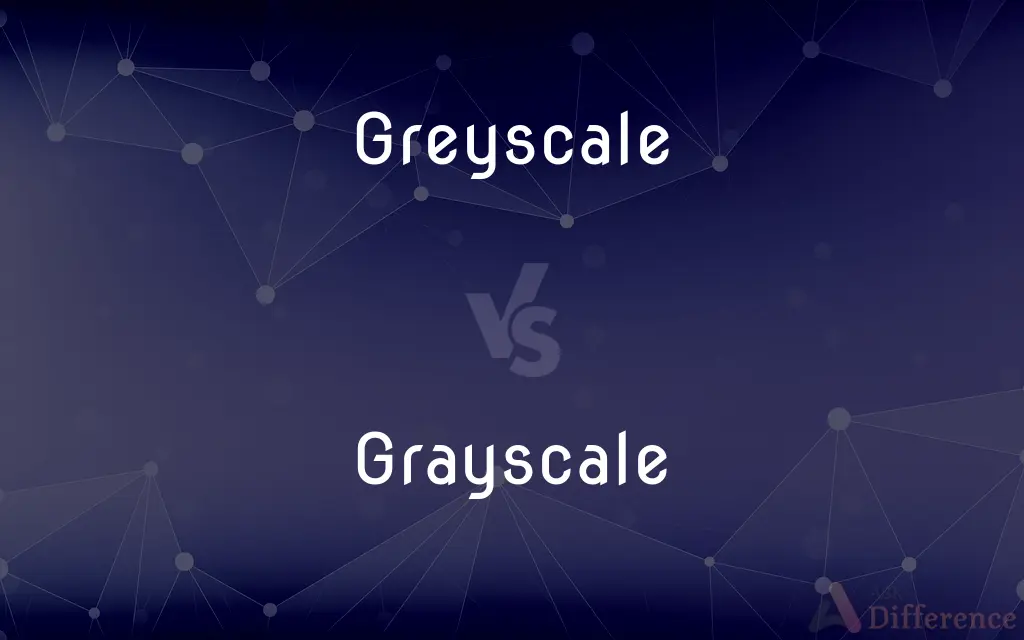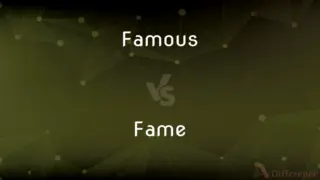Greyscale vs. Grayscale — What's the Difference?
Edited by Tayyaba Rehman — By Urooj Arif — Updated on March 6, 2024
Greyscale and Grayscale refer to the same concept of images in shades of gray, differing primarily in spelling by region: greyscale is preferred in British English, while grayscale is favored in American English.

Difference Between Greyscale and Grayscale
Table of Contents
ADVERTISEMENT
Key Differences
Greyscale and grayscale both describe an image, display, or printing process that uses various shades of gray, from black to white, without color. The key difference between the two terms lies in their regional spelling preferences. Greyscale is commonly used in British English, aligning with the British spelling of "grey." Conversely, grayscale follows the American English spelling preference, using "gray."
Both terms are used in digital and print photography, film, and computer graphics to describe images that contain only shades of gray, emphasizing texture, light, and shadow without color. Greyscale might appear more frequently in publications and discussions originating from the UK or countries following British English conventions, whereas grayscale is predominant in American publications and technical documents.
In the context of color theory and digital imaging, greyscale and grayscale images are created by varying the brightness of pixels. These images are crucial for analyzing the light intensity in photography, cinematography, and digital art, providing a nuanced understanding of image composition. Whether spelled as greyscale or grayscale, the term reflects the process of eliminating color to focus on light intensity and contrast.
Despite the difference in spelling, there is no distinction in meaning or application between greyscale and grayscale. The choice between the two spellings often depends on the writer's or publisher's location or the intended audience's regional spelling practices.
In technical settings, such as programming, graphic design, and image processing, both spellings are understood and accepted. Software and technical documentation might use one spelling over the other based on the origin of the software company or the primary audience. However, this does not affect the functionality or interpretation of greyscale/grayscale images in these contexts.
ADVERTISEMENT
Comparison Chart
Spelling Region
British English
American English
Usage
In regions following British English conventions
In regions following American English conventions
Definition
Images or processes in shades of gray
Same as greyscale
Contextual Preference
UK, Commonwealth countries, and others
United States and countries using American English
Technical Application
Identical in digital imaging, photography, etc.
Identical to greyscale
Compare with Definitions
Greyscale
Common in digital and print photography.
He printed the landscape in greyscale to focus on its texture.
Grayscale
A spectrum of gray shades from black to white, used in imaging.
Grayscale mode simplifies the design process.
Greyscale
Used in British English spelling.
The greyscale conversion tool is widely used in UK software.
Grayscale
Common in U.S. software and documentation.
The software's manual refers to the 'grayscale' setting.
Greyscale
A range of shades of gray without any color.
The photographer prefers shooting in greyscale for dramatic effect.
Grayscale
Highlights differences in intensity.
The grayscale filter helps in assessing the photo's exposure.
Greyscale
Emphasizes texture and light.
Greyscale images highlight the contrast between light and shadow.
Grayscale
Essential for monochromatic art.
His grayscale sketches are known for their depth and intensity.
Greyscale
Preferred in UK-based publications.
The art book was published in greyscale to match British spelling conventions.
Grayscale
Favored in American English.
American graphic designers often use the term grayscale.
Greyscale
A range of grey shades from white to black, as used in a monochrome display or printout
A greyscale scanner
Grayscale
An image displayed using such a series of shades.
Grayscale
(imaging) The use of black and white, representing color with shades of gray.
Grayscale
(imaging) Black and white, representing color with shades of gray.
Grayscale
(transitive) To convert to grayscale.
Grayscale
In digital photography, computer-generated imagery, and colourimetry, a greyscale image is one in which the value of each pixel is a single sample representing only an amount of light; that is, it carries only intensity information. Greyscale images, a kind of black-and-white or grey monochrome, are composed exclusively of shades of grey.
Grayscale
A series of shades ranging from pure white to pure black, used in displaying monochromatic images.
Grayscale
(photography) A printed strip of graduated tones used to check exposure and development times.
Common Curiosities
Why are there two spellings for greyscale/grayscale?
The two spellings reflect the different conventions for spelling "grey/gray" in British and American English.
Can greyscale and grayscale be used interchangeably?
Yes, they can be used interchangeably, as they refer to the same concept of shades of gray in images.
Do software programs prefer one spelling over the other?
Software developed or primarily marketed in American English-speaking countries may prefer "grayscale," while those in British English-speaking regions might use "greyscale."
How do I choose between greyscale and grayscale?
Choose based on your regional spelling practices or the preferences of your intended audience.
What is the difference between greyscale and grayscale?
The difference lies only in regional spelling preferences: "greyscale" for British English and "grayscale" for American English.
How does greyscale/grayscale affect the perception of an image?
It can make viewers focus more on composition, texture, and tonal contrast, often evoking a different emotional response than color images.
Is there any technical difference between greyscale and grayscale images?
No, there is no technical difference; the terms describe the same process and result in digital imaging.
Are greyscale and grayscale images popular in photography?
Yes, they are popular for their ability to focus on texture, contrast, and light intensity without the distraction of color.
Can greyscale/grayscale images be colored?
Yes, greyscale/grayscale images can serve as a base for digital coloring or hand-coloring techniques.
Can converting to greyscale/grayscale improve an image's appearance?
Converting to greyscale/grayscale can highlight certain aspects of an image, such as texture and contrast, potentially enhancing its visual impact.
Is greyscale/grayscale used only in photography?
No, it's also used in film, television, digital art, and printing to convey texture, depth, and emotional tone without color.
Why might an artist choose greyscale/grayscale over color?
An artist might choose it to emphasize form and light, reduce distractions, or convey a specific mood or historical feel.
Are there cultural implications in the preference for greyscale or grayscale?
The preference is more about regional language use than culture, with no significant cultural implications in the choice.
What skills are important for creating effective greyscale/grayscale images?
Understanding light, shadow, contrast, and texture is crucial for creating impactful greyscale/grayscale images.
How do I convert a color image to greyscale/grayscale?
Most photo editing software has a tool or option to convert images to greyscale/grayscale, often with a single click.
Share Your Discovery

Previous Comparison
Cast vs. Casted
Next Comparison
Famous vs. FameAuthor Spotlight
Written by
Urooj ArifUrooj is a skilled content writer at Ask Difference, known for her exceptional ability to simplify complex topics into engaging and informative content. With a passion for research and a flair for clear, concise writing, she consistently delivers articles that resonate with our diverse audience.
Edited by
Tayyaba RehmanTayyaba Rehman is a distinguished writer, currently serving as a primary contributor to askdifference.com. As a researcher in semantics and etymology, Tayyaba's passion for the complexity of languages and their distinctions has found a perfect home on the platform. Tayyaba delves into the intricacies of language, distinguishing between commonly confused words and phrases, thereby providing clarity for readers worldwide.















































